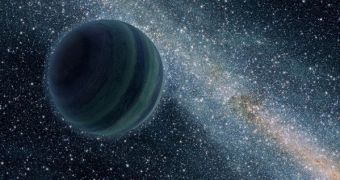Every galaxy may contain a very large number of extrasolar planets that is not bound to a parent star. These Jupiter-mass objects roam through the darkness of space without orbiting a star, or anything else for that matter.
According to astronomers, this population is many times larger than originally estimated. In the past, it was thought that such celestial bodies existed only in small numbers, but new data are suggesting that they may in fact be common in the Universe.
Experts now believe that some of these unbound planets may in fact be orbiting parent stars, but at a very large distance. Regardless of whether this is true or not, the fact remains that the majority of these objects are not orbiting anything.
What the newest study on the issue shows is that these exoplanets are twice more common in the Milky Way than main-sequence stars. Their numbers also exceed those of regular, star-bound exoplanets by as much as 50 percent, the data indicate.
Understandably, finding these planets is not that easy, so astronomers used an investigations method called gravitational microlensing for the job. The research was carried out by a team based at the Osaka University, in Japan.
“Previous observations of bound planets tell us only about planets which are surviving in orbits now. However, [these] findings inform us how many planets have formed and scattered out,” explains OU expert Takahiro Sumi.
The astronomer is also the lead author of a new report detailing the findings, which appeared in the May 18 issue of the top scientific journal Nature. Experts say that gravitational microlensing has thus far been used to discover about 12 of the 550 confirmed exoplanets.
In order to carry out the research, experts monitored 24 months of data collected by a New Zealand-based telescope. The instrument was monitoring about 50 million stars in the Milky Way.
The Japanese researchers were able to identify no less than 474 such events. Of these, about 10 lasted less than two days, which indicated that the objects being observed were Jupiter-mass exoplanets. However, their signature was not accompanied by that of any kind of star.
Later observations conducted with other telescopes confirmed that these planets were either orbiting their parent stars at at least 10 astronomical units, or they were entirely unbound. An astronomical unit is the mean distance between the Sun and the Earth, or about 93 million miles, Space reports.
“The implications of this discovery are profound. We have a first glimpse of a new population of planetary-mass objects in our galaxy. Now we need to explore their properties, distribution, dynamic states and history,” comments Heidelberg University astronomer Joachim Wambsganss

 14 DAY TRIAL //
14 DAY TRIAL //